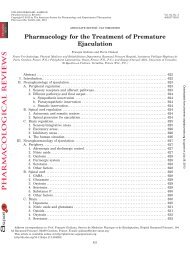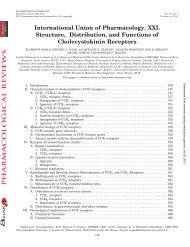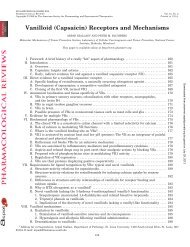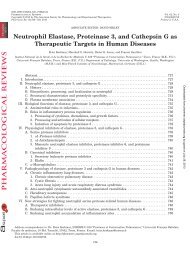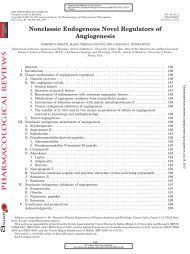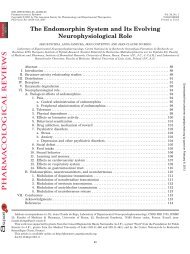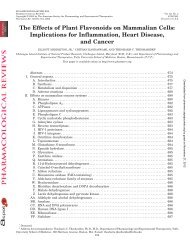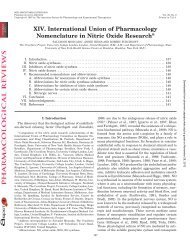Opioids, Reward and Addiction: An Encounter of Biology ...
Opioids, Reward and Addiction: An Encounter of Biology ...
Opioids, Reward and Addiction: An Encounter of Biology ...
You also want an ePaper? Increase the reach of your titles
YUMPU automatically turns print PDFs into web optimized ePapers that Google loves.
self-administration behavior according to the unit dose<br />
delivered, with a maximum number <strong>of</strong> self-infusions at a<br />
unit dose <strong>of</strong> 30 g/kg/inf (Fig. 1) (Smith et al., 1976). In<br />
rats <strong>of</strong>fered morphine via an intragastric route, a unit<br />
dose <strong>of</strong> 30 g/kg/inf morphine did not maintain responding.<br />
The curve <strong>of</strong> intragastric morphine reinforcement<br />
was shifted to the right <strong>and</strong> the maximum number <strong>of</strong><br />
self-infusions was lower than with the i.v. route (maximum<br />
number <strong>of</strong> self-infusions at 300 g/kg/inf). These<br />
data indicate that the i.v. route enables a more potent<br />
(<strong>and</strong> efficacious) behavioral effect <strong>of</strong> morphine. Placement<br />
<strong>of</strong> the drug directly into the blood as compared<br />
with oral delivery enables a higher quantity <strong>of</strong> the agent<br />
at its site <strong>of</strong> action with a more rapid onset, which<br />
probably increases the drugs’ reinforcing effects. Administration<br />
<strong>of</strong> morphine via the intragastric route might<br />
cause loss <strong>of</strong> potential through incomplete <strong>and</strong> slow absorption,<br />
biotransformation, <strong>and</strong> delayed latency <strong>of</strong> onset<br />
(Iwamoto <strong>and</strong> Klaassen, 1977).<br />
3. Schedules <strong>of</strong> Reinforcement. Schedules <strong>of</strong> reinforcement<br />
or schedules <strong>of</strong> drug availability can influence<br />
opioid self-administration behavior in animals. The<br />
schedules used include fixed ratio (FR) schedules where<br />
a fixed number <strong>of</strong> behavioral responses is required to<br />
obtain a drug, <strong>and</strong> fixed interval schedules where the<br />
drug can be obtained after a fixed amount <strong>of</strong> time responding<br />
for it. Studies with these schedules <strong>of</strong> drug<br />
availability generally show that an increase in response<br />
requirement or interinjection interval decreases the<br />
amount <strong>of</strong> drug self-administered. In general, the influence<br />
<strong>of</strong> the various schedules <strong>of</strong> reinforcement on drug<br />
self-administration is comparable to that on food <strong>and</strong><br />
water reinforcement.<br />
A typical model <strong>of</strong> schedule-controlled responding is<br />
the progressive-ratio paradigm. This model, in which<br />
each next drug infusion requires more responses than<br />
the one before (increased FR requirement), allows the<br />
determination <strong>of</strong> the maximal effort the animal will<br />
perform to receive a drug infusion (“breaking point”).<br />
The breaking point depends on the dose <strong>of</strong> the selfadministered<br />
drug <strong>and</strong> is thought to provide a measure<br />
<strong>of</strong> the reinforcing efficacy <strong>of</strong> the drug. For example,<br />
H<strong>of</strong>fmeister (1979) investigated the reinforcing efficacy<br />
<strong>of</strong> a number <strong>of</strong> opioid drugs in rhesus monkeys using a<br />
day-by-day increasing progressive ratio schedule. Before<br />
opioid drug experiments, stable self-administration behavior<br />
was established with 1-mg/kg codeine infusions<br />
contingent on completion <strong>of</strong> a FR 100. Doses <strong>of</strong> the opioid<br />
drug studied were substituted for codeine <strong>and</strong> the FR<br />
schedules were doubled daily (up to FR 64,000) until the<br />
number <strong>of</strong> self-infusions per day decreased to less then<br />
two infusions (the breaking point). The breaking points<br />
<strong>of</strong> either opioid drug studied, i.e., heroin, codeine, dextropropoxyphene,<br />
<strong>and</strong> pentazocine, increased dosedependently.<br />
The highest breaking point with heroin<br />
(FR 12,800) was observed with infusions <strong>of</strong> 0.5 mg/kg<br />
<strong>and</strong> for codeine (FR 6,400) with a dose <strong>of</strong> 16 mg/kg/inf.<br />
OPIOIDS, REWARD AND ADDICTION 353<br />
When dextropropoxyphene <strong>and</strong> pentazocine maintained<br />
behavior, the highest breaking points (FR 6,400) were<br />
observed with infusions <strong>of</strong> 5 mg/kg. The progressive<br />
ratio paradigm demonstrates a certain rank ordering in<br />
the breaking points, i.e., the reinforcing efficacy, <strong>of</strong> different<br />
opioid drugs. It has been argued that the progressive<br />
ratio model provides a measure <strong>of</strong> drug craving in<br />
the presence <strong>of</strong> the drug (Markou et al., 1993). The<br />
authors emphasize that the breaking point measure is<br />
composed <strong>of</strong> two components: the unconditioned incentive<br />
(i.e., reinforcing) <strong>and</strong> the conditioned incentive<br />
properties <strong>of</strong> the drug. According to this, the fact that<br />
animals will exhibit more effort to receive one <strong>of</strong> two unit<br />
doses can be considered to reflect the relative incentive<br />
motivational value <strong>of</strong> the expected drug dose, <strong>and</strong> thus a<br />
measure <strong>of</strong> drug craving.<br />
<strong>An</strong>other schedule-controlled paradigm, which also is<br />
thought to provide a measure for drug craving, is the<br />
second-order schedule paradigm (Markou et al., 1993). A<br />
second-order schedule is defined as “one in which the<br />
behavior specified by a schedule contingency is treated<br />
as unitary response that is itself reinforced according to<br />
some schedule <strong>of</strong> primary reinforcement” (Kelleher,<br />
1966; Goldberg <strong>and</strong> Gardner, 1981). In short, completion<br />
<strong>of</strong> a specific FR schedule results in the presentation <strong>of</strong> a<br />
brief stimulus <strong>and</strong> completion <strong>of</strong> an overall schedule<br />
produces a brief stimulus <strong>and</strong> a drug injection. For example,<br />
every 30th key-pressing response during a 60min<br />
interval produced a 2-s light; the first 30-response<br />
component completed after 60 min produced both the<br />
light <strong>and</strong> an i.v. injection with morphine (Goldberg <strong>and</strong><br />
Tang, 1977). Under this second-order schedule <strong>of</strong> morphine<br />
injections, high rates <strong>of</strong> responding were maintained<br />
by monkeys <strong>and</strong> the unit dose-response relationship<br />
tends to be an inverted U-shaped curve. The<br />
second-order schedule can be repeated several times<br />
which will result in multiple drug injections. One <strong>of</strong> the<br />
advantages <strong>of</strong> second-order schedules as a model for<br />
drug craving is that animals will perform a high rate <strong>of</strong><br />
responding <strong>and</strong> extended sequences <strong>of</strong> behavior before<br />
any drug administration.<br />
4. Physical Dependence, Tolerance, <strong>and</strong> Sensitization.<br />
Repeated self-administration <strong>of</strong> drugs may alter a variety<br />
<strong>of</strong> homeostatic mechanisms, changes that alternatively<br />
may contribute more or less to drug-taking behavior.<br />
The development <strong>of</strong> physical dependence <strong>and</strong><br />
tolerance is <strong>of</strong> particular interest, since these phenomena<br />
have been regarded in the past as being critically<br />
involved in opioid addiction.<br />
Physical dependence refers to an altered physiological<br />
state produced by the repeated administration <strong>of</strong> a drug,<br />
which necessitates the continued administration <strong>of</strong> the<br />
drug to prevent the appearance <strong>of</strong> a withdrawal or abstinence<br />
syndrome (Jaffe, 1990). Tolerance represents a<br />
decrease in effectiveness <strong>of</strong> a drug after repeated administration<br />
<strong>and</strong> consequently the need for a higher dose to<br />
produce the same effect. Treatment <strong>of</strong> animals with



